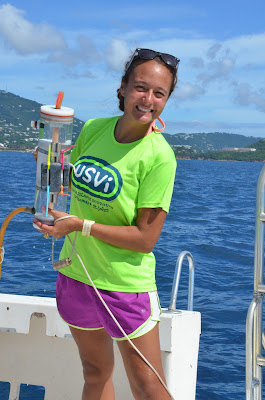 |
| A post-storm sunset captured from the beach in St. Croix, while the Foster (far left) is docked in port |
Another cruise is in the books! We can't believe it's over already! This year's cruise was defined by balancing new sampling techniques and research goals with familiar methods and regions.
We made history by becoming the first federal vessel to dock in Havana, Cuba, since the restoration of diplomatic relations between the two countries, but also returned to the familiar U.S. Virgin Islands, where we sampled for the 7th year. We updated our usual pre-determined sampling plan in order to explore the dynamics of ever-changing mesoscale eddies, yet maintained the integrity of historical sampling sites. We welcomed new faces on board, including Cuban observers, and rekindled relationships with colleagues from years past.
Some final stats for Legs 1, 2, and 3 combined:
 |
| Sarah and Alexis rinse down the S25 net |
- CTD casts = 121
- S10/S25 net tows = 105
- Bongo tows = 41
- Neuston tows = 17
- MOCNESS = 74
- mini-Bongo tows = 66
- drifters deployed = 13
- plankton samples collected = over 500!
- countries visited = 4 (U.S., Cuba, Mexico, Jamaica)
- collaborating countries = 7 (U.S., Mexico, Cuba, Japan, Spain, France, Dominican Republic)
- collaborating institutions = 15
We still have lots of work left to do - unloading the ship, unpacking, cleaning, and repairing all our gear, sorting over 500 plankton samples, identifying larval fish, processing CTD files, running chlorophyll and isotope samples, and more! While we get back to work, check out some of our final images and videos from the last leg of the cruise, and be sure to check back for more next year!
Thanks for reading and sharing in our NF-16-02 adventures!
 |
| Leg 3! L-R: Omar, Trika, Sennai, Dan, Alexis, Aras, Mara, Ryan, Alex, Kathryn, Sarah, Adrianne, Angela, LaTreese |
 |
| Aras patiently filters the mini-Bongo sample through find mesh funnels |
Time-lapse: MOCNESS retrieval!
(Video by Mara Duke)
Time-lapse: S25 tow - this was in very shallow water so you can see the ocean floor!
(Video by Mara Duke)
 |
| Adrianne and Angela deploy the CTD while ST Nick directs the winch operator |
 |
| Ryan takes water samples from the CTD rosette bottles (top), then treats them so the oxygen concentration can be measured back in the lab (bottom). |
 |
| Omar (L) rinses the S25 neuston net, while Adrianne and Kathryn hold it steady. Safety first! Everyone wears hard hats and PFDs, and are tethered to the deck with a safety line. |
 |
| Day Shift Rules! Mara, Sarah, Sennai, and Alexis take a selfie in their safety gear. |
 |
| Night Shift makes you crazy! LaTreese, Adrianne, Alex, Omar, Angela, Aars, & Kathryn started work at midnight everyday! |
 |
| We're done! See you next year!! |












































